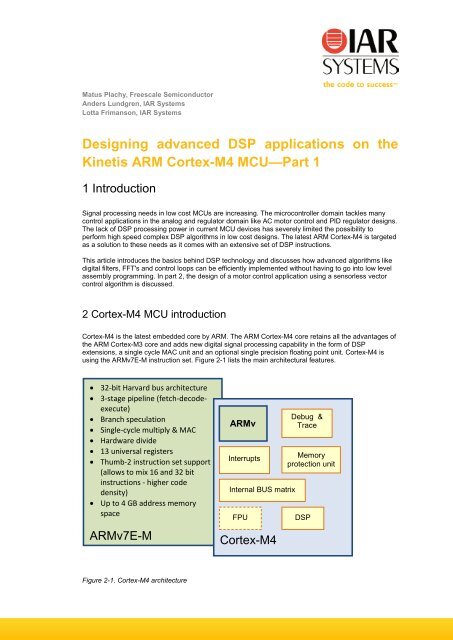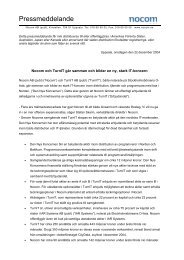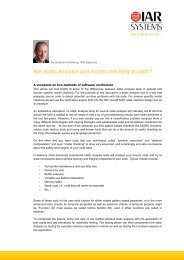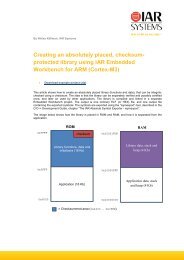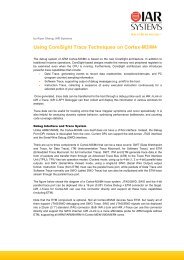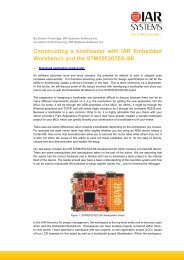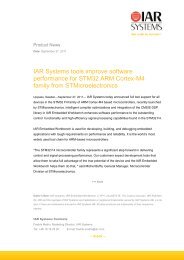Designing advanced DSP applications on the Kinetis ARM Cortex ...
Designing advanced DSP applications on the Kinetis ARM Cortex ...
Designing advanced DSP applications on the Kinetis ARM Cortex ...
You also want an ePaper? Increase the reach of your titles
YUMPU automatically turns print PDFs into web optimized ePapers that Google loves.
Matus Plachy, Freescale Semic<strong>on</strong>ductor<br />
Anders Lundgren, IAR Systems<br />
Lotta Frimans<strong>on</strong>, IAR Systems<br />
<str<strong>on</strong>g>Designing</str<strong>on</strong>g> <str<strong>on</strong>g>advanced</str<strong>on</strong>g> <str<strong>on</strong>g>DSP</str<strong>on</strong>g> <str<strong>on</strong>g>applicati<strong>on</strong>s</str<strong>on</strong>g> <strong>on</strong> <strong>the</strong><br />
<strong>Kinetis</strong> <strong>ARM</strong> <strong>Cortex</strong>-M4 MCU—Part 1<br />
1 Introducti<strong>on</strong><br />
Signal processing needs in low cost MCUs are increasing. The microc<strong>on</strong>troller domain tackles many<br />
c<strong>on</strong>trol <str<strong>on</strong>g>applicati<strong>on</strong>s</str<strong>on</strong>g> in <strong>the</strong> analog and regulator domain like AC motor c<strong>on</strong>trol and PID regulator designs.<br />
The lack of <str<strong>on</strong>g>DSP</str<strong>on</strong>g> processing power in current MCU devices has severely limited <strong>the</strong> possibility to<br />
perform high speed complex <str<strong>on</strong>g>DSP</str<strong>on</strong>g> algorithms in low cost designs. The latest <strong>ARM</strong> <strong>Cortex</strong>-M4 is targeted<br />
as a soluti<strong>on</strong> to <strong>the</strong>se needs as it comes with an extensive set of <str<strong>on</strong>g>DSP</str<strong>on</strong>g> instructi<strong>on</strong>s.<br />
This article introduces <strong>the</strong> basics behind <str<strong>on</strong>g>DSP</str<strong>on</strong>g> technology and discusses how <str<strong>on</strong>g>advanced</str<strong>on</strong>g> algorithms like<br />
digital filters, FFT's and c<strong>on</strong>trol loops can be efficiently implemented without having to go into low level<br />
assembly programming. In part 2, <strong>the</strong> design of a motor c<strong>on</strong>trol applicati<strong>on</strong> using a sensorless vector<br />
c<strong>on</strong>trol algorithm is discussed.<br />
2 <strong>Cortex</strong>-M4 MCU introducti<strong>on</strong><br />
<strong>Cortex</strong>-M4 is <strong>the</strong> latest embedded core by <strong>ARM</strong>. The <strong>ARM</strong> <strong>Cortex</strong>-M4 core retains all <strong>the</strong> advantages of<br />
<strong>the</strong> <strong>ARM</strong> <strong>Cortex</strong>-M3 core and adds new digital signal processing capability in <strong>the</strong> form of <str<strong>on</strong>g>DSP</str<strong>on</strong>g><br />
extensi<strong>on</strong>s, a single cycle MAC unit and an opti<strong>on</strong>al single precisi<strong>on</strong> floating point unit. <strong>Cortex</strong>-M4 is<br />
using <strong>the</strong> <strong>ARM</strong>v7E-M instructi<strong>on</strong> set. Figure 2-1 lists <strong>the</strong> main architectural features.<br />
• 32-bit Harvard bus architecture<br />
• 3-stage pipeline (fetch-decodeexecute)<br />
• Branch speculati<strong>on</strong><br />
• Single-cycle multiply & MAC<br />
• Hardware divide<br />
• 13 universal registers<br />
• Thumb-2 instructi<strong>on</strong> set support<br />
(allows to mix 16 and 32 bit<br />
instructi<strong>on</strong>s - higher code<br />
density)<br />
• Up to 4 GB address memory<br />
space<br />
<strong>ARM</strong>v7E-M<br />
Figure 2-1. <strong>Cortex</strong>-M4 architecture<br />
<strong>ARM</strong>v<br />
Interrupts<br />
Internal BUS matrix<br />
<strong>Cortex</strong>-M4<br />
Debug &<br />
Trace<br />
Memory<br />
protecti<strong>on</strong> unit<br />
FPU <str<strong>on</strong>g>DSP</str<strong>on</strong>g>
3 <str<strong>on</strong>g>DSP</str<strong>on</strong>g> lecture lite<br />
3.1 Saturating arithmetic’s<br />
Saturating arithmetic is <strong>the</strong> most important requirement for digital signal processing. The term<br />
“saturating” comes from analog electr<strong>on</strong>ics, in which an amplifier output will be limited (clipped),<br />
between fixed values when a large input is applied. Audio, graphics, video and c<strong>on</strong>trol loops all behave<br />
reas<strong>on</strong>able well if overflow c<strong>on</strong>diti<strong>on</strong>s limit <strong>the</strong> signal to min and max instead of wrapping around to<br />
some unexpected value. A graphics pixel is a good example; adding a large value to an almost white<br />
pixel using saturating arithmetic will give a maximum white pixel. Doing <strong>the</strong> same operati<strong>on</strong> with<br />
standard CPU arithmetic could give any color as <strong>the</strong> result of <strong>the</strong> wrap around. The saturating behavior<br />
is clearly <strong>the</strong> preferred choice here.<br />
To illustrate <strong>the</strong> difference between saturating arithmetic and standard CPU arithmetic we take a sine<br />
wave as shown in Figure 3-1. The sine wave is scaled to fit within <strong>the</strong> 16-bit signed range of -32768 to<br />
32767. Processing <strong>the</strong> sine wave by scaling it by a factor 1.5 will cause overflow, <strong>the</strong> resulting waveform<br />
for standard CPU arithmetic is shown in figure 3-2, and for saturating arithmetic in Figure 3-3. In both<br />
overflow cases, <strong>the</strong> scaled waveforms show wr<strong>on</strong>g behavior, but whereas Figure 3-3 is merely<br />
clipped/distorted, <strong>the</strong> waveform in Figure 3-2 is completely incorrect. Saturating arithmetic will preserve<br />
<strong>the</strong> characteristics of a waveform when overdriven; <strong>the</strong> resulting system will be robust to large signals.<br />
The effect is similar to turning <strong>the</strong> volume knob to high <strong>on</strong> a stereo amplifier, <strong>the</strong> sound quality will<br />
decrease but <strong>the</strong> music will still be discernible.<br />
Figure 3-1. No overflow Figure 3-2. Overflow –<br />
standard CPU arithmetic<br />
Figure 3-3. Overflow –<br />
saturating arithmetic<br />
3.2 Data types<br />
<str<strong>on</strong>g>DSP</str<strong>on</strong>g> operati<strong>on</strong>s can use ei<strong>the</strong>r floating-point or fixed-point format. The <strong>Cortex</strong>-M4 core has opti<strong>on</strong>al<br />
hardware support for 32-bit floating-point, but is not optimized for <str<strong>on</strong>g>DSP</str<strong>on</strong>g> algorithms and too slow for most<br />
<str<strong>on</strong>g>DSP</str<strong>on</strong>g> <str<strong>on</strong>g>applicati<strong>on</strong>s</str<strong>on</strong>g>. Available fixed-point data sizes in <strong>Cortex</strong>-M4 are 8, 16, 32 and 64 bits. Saturating<br />
arithmetic is supported <strong>on</strong> 8, 16 and 32 bits.<br />
The fixed-point format can be integer, fracti<strong>on</strong>al or a mix of integer and fracti<strong>on</strong>al. The notati<strong>on</strong> used to<br />
describe <strong>the</strong> format of a fixed point number is Qm.f, where m is <strong>the</strong> number of integer bits and f is <strong>the</strong><br />
number of fracti<strong>on</strong>al bits. Q3.12 for example denotes a fixed point data type with 3 integer bits and 12<br />
fracti<strong>on</strong>al bits, it will fit in a 16-bit register with <strong>the</strong> remaining bit as a sign bit. The most comm<strong>on</strong> format<br />
used for <str<strong>on</strong>g>DSP</str<strong>on</strong>g> operati<strong>on</strong>s is Q0.15 and Q0.31, with <strong>on</strong>ly fracti<strong>on</strong>al bits to represent numbers between -<br />
1.0 and + 1.0. It is comm<strong>on</strong> to omit <strong>the</strong> leading ‘0.’ and simply write Q15 and Q31. The representati<strong>on</strong> of<br />
a Q15 number is:<br />
𝑣𝑎𝑙𝑢𝑒 = 𝑏 14 ∗ 2 −1 + 𝑏 13 ∗ 2 −2 + ⋯ + 𝑏 1 ∗ 2 −14 + 𝑏 0 ∗ 2 −15<br />
For example <strong>the</strong> number 0.5 will be encoded in Q15 as 0x4000.<br />
Integer arithmetic (saturating and n<strong>on</strong>-saturating) instructi<strong>on</strong>s can be used <strong>on</strong> Qm.f numbers for additi<strong>on</strong><br />
and subtracti<strong>on</strong>. For multiplicati<strong>on</strong> and divisi<strong>on</strong>, scaling is needed, for example multiplying Qm.f with<br />
Qn.g will result in a Q(m+n).(f+g) number.<br />
3.3 <str<strong>on</strong>g>DSP</str<strong>on</strong>g> instructi<strong>on</strong>s<br />
The <strong>Cortex</strong>-M4 has a number of instructi<strong>on</strong>s to support <str<strong>on</strong>g>DSP</str<strong>on</strong>g> algorithms in an efficient way. Let’s take<br />
look at <strong>the</strong> most important <strong>on</strong>es.<br />
Page 2
3.3.1 Saturating instructi<strong>on</strong>s<br />
A set of instructi<strong>on</strong>s are available for saturating additi<strong>on</strong> and subtracti<strong>on</strong> of 8, 16 and 32-bit values;<br />
QADD8, QSUB8, QADD16, QSUB16, QADD and QSUB.<br />
The SSAT instructi<strong>on</strong> is available to scale and saturate a value to any bit width that fits a 32-bit value.<br />
3.3.2 MAC instructi<strong>on</strong>s<br />
Most <str<strong>on</strong>g>DSP</str<strong>on</strong>g> algorithms rely heavily <strong>on</strong> accumulating <strong>the</strong> result of l<strong>on</strong>g series of multiplicati<strong>on</strong>s. This is <strong>the</strong><br />
case for FIR and IIR filters, but also for complex algorithms like FFT and DCT. Performing <strong>the</strong><br />
multiplicati<strong>on</strong> and accumulati<strong>on</strong> by a single cycle instructi<strong>on</strong> is key to high performance. Some of <strong>the</strong><br />
<strong>Cortex</strong>-M4 MAC instructi<strong>on</strong>s are:<br />
• SMLA – is used for Q15 calculati<strong>on</strong>s; it performs <strong>the</strong> operati<strong>on</strong> 32 += 16*16 (multiplies two 16bit<br />
values and adds <strong>the</strong> result to a 32-bit register)<br />
• SMLAL – is used for Q31 calculati<strong>on</strong>s; it performs <strong>the</strong> operati<strong>on</strong> 64 += 32*32. There is also a<br />
variant of <strong>the</strong> SMLAL instructi<strong>on</strong> to perform <strong>the</strong> operati<strong>on</strong> 64 += 16*16<br />
3.3.3 SIMD instructi<strong>on</strong>s<br />
The availability of suitable instructi<strong>on</strong>s for implementing <str<strong>on</strong>g>DSP</str<strong>on</strong>g> algorithms is a real advantage of <strong>the</strong><br />
<strong>Cortex</strong>-M4. To increase performance even more it would be nice to perform several operati<strong>on</strong>s in<br />
parallel. As discussed above, <strong>the</strong> MAC instructi<strong>on</strong>s performs a multiply and an additi<strong>on</strong> in a single cycle.<br />
On top of that <strong>the</strong>re is SIMD (Single Instructi<strong>on</strong> Multiple Data) to perform multiple identical operati<strong>on</strong>s in<br />
a single cycle instructi<strong>on</strong>. Some of <strong>the</strong> available SIMD instructi<strong>on</strong>s are:<br />
• QADD8 – performs four 8-bit saturating additi<strong>on</strong>s<br />
• QADD16 – performs two 16-bit saturating additi<strong>on</strong>s<br />
• SMLAD – performs a dual MAC operati<strong>on</strong> 32 += 16*16 + 16*16<br />
• SMLALD – performs a dual MAC operati<strong>on</strong> 64 += 16*16 + 16*16<br />
• SSAT16 – performs two scale and saturate operati<strong>on</strong>s<br />
3.4 Algorithms<br />
3.4.1 Filters<br />
The two most comm<strong>on</strong> digital filters are FIR (Finite Impulse Resp<strong>on</strong>se) and IIR (Infinite Impulse<br />
Resp<strong>on</strong>se).<br />
• FIR filters use no feedback and are <strong>the</strong>refore inherently stable. In <strong>the</strong> FIR equati<strong>on</strong> below 𝑥 is<br />
<strong>the</strong> input samples vector, 𝑦 is <strong>the</strong> output vector, 𝑁 is <strong>the</strong> filter order, and 𝑏 is <strong>the</strong> filter<br />
coefficients.<br />
𝑁<br />
𝑦[𝑛] = � 𝑏 𝑖𝑥[𝑛 − 𝑖]<br />
𝑖=0<br />
• IIR filters use feedback and can show instability if not designed properly. IIR filter can be used<br />
to implement <strong>the</strong> well know analog filter types Butterworth, Chebyshev, Bessel and o<strong>the</strong>rs. In<br />
<strong>the</strong> IIR equati<strong>on</strong> below, 𝑥 is <strong>the</strong> input samples vector, 𝑦 is <strong>the</strong> output vector, 𝑃 is <strong>the</strong><br />
feedforward filter order, 𝑄 is <strong>the</strong> feedback filter order, and 𝑎/𝑏 are <strong>the</strong> filter coefficients.<br />
𝑦[𝑛] = 1<br />
𝑃<br />
� 𝑏 𝑖𝑥[𝑛 − 𝑖] − 1<br />
𝑄<br />
� 𝑎 𝑗𝑦[𝑛 − 𝑗]<br />
𝑎 0<br />
𝑖=0<br />
𝑎 0<br />
𝑗=0<br />
3.4.2 Transforms<br />
A transform is a functi<strong>on</strong> that maps data from its original domain into ano<strong>the</strong>r domain. Typical examples<br />
of transforms are FFT (Fast Fourier Transform) and DCT (Discrete Cosine Transform). Bo<strong>the</strong> <strong>the</strong> FFT<br />
and DCT can map data from <strong>the</strong> time domain to <strong>the</strong> frequency domain, and vice versa.<br />
In our motor c<strong>on</strong>trol example in secti<strong>on</strong> 5 we will use <strong>the</strong> Clarke and Park transforms. Combined <strong>the</strong>y<br />
will transform <strong>the</strong> motor rotating 3-phase field current to a rotor magnetizing flux and torque comp<strong>on</strong>ent.<br />
Transforms are computati<strong>on</strong>al intensive, especially for large input vectors/matrixes. C<strong>on</strong>siderable<br />
performance gains can be obtained using <strong>the</strong> <strong>Cortex</strong>-M4 <str<strong>on</strong>g>DSP</str<strong>on</strong>g> specific instructi<strong>on</strong>s.<br />
3.4.3 C<strong>on</strong>trol loops<br />
Motor c<strong>on</strong>trol requires fast and stable c<strong>on</strong>trol loops as will be more discussed in secti<strong>on</strong> 5. An example<br />
of a comm<strong>on</strong> c<strong>on</strong>trol loop is <strong>the</strong> PID c<strong>on</strong>troller.<br />
Page 3
4. <str<strong>on</strong>g>DSP</str<strong>on</strong>g> applicati<strong>on</strong> development support<br />
4.1 Development tool requirements<br />
To help you use <strong>the</strong> features <strong>on</strong> <strong>the</strong> <strong>Cortex</strong>-M4 core, <strong>the</strong>re is a multitude of support from <strong>the</strong><br />
development tools domain. Complex hardware needs to be easy to program and easy-to-use tools are<br />
very important. Executi<strong>on</strong>s speed is very essential in <str<strong>on</strong>g>DSP</str<strong>on</strong>g> <str<strong>on</strong>g>applicati<strong>on</strong>s</str<strong>on</strong>g> and that puts requirements <strong>on</strong><br />
<strong>the</strong> build chain. The compiler must be very good at optimizing <strong>the</strong> code for speed.<br />
Software development costs and time-to-market requirements are o<strong>the</strong>r important factors in all projects.<br />
Development tools <strong>the</strong>refor must comply and support both software standards and programming<br />
standards. To reuse and port code, compiler extensi<strong>on</strong>s like intrinsic functi<strong>on</strong>s need to follow a standard.<br />
4.1.1 CMSIS<br />
The <strong>ARM</strong>® <strong>Cortex</strong> Microc<strong>on</strong>troller Software Interface Standard (CMSIS) is a vendor-independent<br />
hardware abstracti<strong>on</strong> layer for all <strong>Cortex</strong>-M processor based devices. CMSIS has been developed by<br />
<strong>ARM</strong> in c<strong>on</strong>juncti<strong>on</strong> with silic<strong>on</strong>, tools and middleware partners. The idea behind CMSIS is to provide a<br />
c<strong>on</strong>sistent and simple software interfaces to <strong>the</strong> processor for interface peripherals, real-time operating<br />
systems, and middleware, simplifying software re-use, reducing <strong>the</strong> learning curve for new<br />
microc<strong>on</strong>troller developers and reducing <strong>the</strong> time to market for new devices.<br />
Every CMSIS-compliant C compiler supports <strong>the</strong> <strong>Cortex</strong>-M4 extensi<strong>on</strong>s defined by <strong>ARM</strong>. This means for<br />
example that if you use a CMSIS-compliant compiler, <strong>the</strong> <str<strong>on</strong>g>DSP</str<strong>on</strong>g> related intrinsic functi<strong>on</strong>s are named<br />
according to <strong>the</strong> standard and your code will be portable between different compilers.<br />
4.2 <str<strong>on</strong>g>DSP</str<strong>on</strong>g> algorithm implementati<strong>on</strong><br />
4.2.1 Assembler<br />
One way of implementing <str<strong>on</strong>g>DSP</str<strong>on</strong>g> functi<strong>on</strong>s is of course to write <strong>the</strong> algorithms in assembler. This can<br />
result in a very high performance when it comes to fast and efficient executi<strong>on</strong>, but assembly<br />
optimizati<strong>on</strong> is hard work and extends <strong>the</strong> development time.<br />
4.2.2 Intrinsic functi<strong>on</strong>s<br />
Ano<strong>the</strong>r alternative is to implement <str<strong>on</strong>g>DSP</str<strong>on</strong>g> algorithms in C or C++. The <strong>Cortex</strong>-M4 processors can be fully<br />
programmed in C and code written in C is easy to write, maintain, and can easily be ported.<br />
The C language does not have any built-in specific support for expressing saturating arithmetic, such<br />
that INT_MAX + n =INT_ MAX and INT_MIN – n = INT_MIN. The operati<strong>on</strong> can be expressed as:<br />
uint16_t saturating_16bit_add(uint16_t a, uint16_t b)<br />
{<br />
uint16_t result = a + b;<br />
if (((a ^ b) & 0x8000) == 0)<br />
{<br />
if ((result ^ a) & 0x8000)<br />
{<br />
result = (a < 0) ? 0x8000 : 0x7fff;<br />
}<br />
}<br />
return result;<br />
}<br />
The compiler could be designed to recognize this c<strong>on</strong>struct and generate <strong>the</strong> proper <strong>Cortex</strong>-M4<br />
saturating instructi<strong>on</strong> for those C statements. Even <strong>the</strong>n, <strong>the</strong> source code is clumsy, error pr<strong>on</strong>e and<br />
difficult to read.<br />
We somehow need to be able to access <str<strong>on</strong>g>DSP</str<strong>on</strong>g> instructi<strong>on</strong>s in a direct and transparent way. This can be<br />
d<strong>on</strong>e with <strong>the</strong> use of intrinsic functi<strong>on</strong>s which is a predefined set of functi<strong>on</strong>s available in <strong>the</strong> compiler.<br />
The intrinsic functi<strong>on</strong>s provide direct access to low-level processor operati<strong>on</strong>s and compile into inline<br />
code, ei<strong>the</strong>r as a single instructi<strong>on</strong> or as a short sequence of instructi<strong>on</strong>s. To make code portable, <strong>the</strong><br />
intrinsic functi<strong>on</strong>s provided by <strong>the</strong> tool vendor must c<strong>on</strong>form to a standard, for example CMSIS.<br />
Page 4
Using <strong>Cortex</strong>-M4 intrinsic functi<strong>on</strong>s, <strong>the</strong> functi<strong>on</strong> above can us <strong>the</strong> intrinsic functi<strong>on</strong> __QADD16 and be<br />
re-written as:<br />
uint16_t saturating_16bit_add(uint16_t a, uint16_t b)<br />
{<br />
return __QADD16(a, b);<br />
}<br />
4.3 <str<strong>on</strong>g>DSP</str<strong>on</strong>g> library<br />
4.3.1 Overview<br />
The alternative to writing your own <str<strong>on</strong>g>DSP</str<strong>on</strong>g> implementati<strong>on</strong> is to use a <str<strong>on</strong>g>DSP</str<strong>on</strong>g> library. Most <str<strong>on</strong>g>DSP</str<strong>on</strong>g> libraries are<br />
supplied by <strong>the</strong> chip vendor and are targeted to a specific architecture. These libraries are often written<br />
in assembler to get <strong>the</strong> best performance and are by that not portable to a different architecture.<br />
There are also both commercial and public domain <str<strong>on</strong>g>DSP</str<strong>on</strong>g> libraries available that are written in C or C++,<br />
like FFTW, SigLib and o<strong>the</strong>rs. These libraries are portable and optimized for speed.<br />
<strong>ARM</strong> has recently launched a standardized <str<strong>on</strong>g>DSP</str<strong>on</strong>g> Library with highly optimized signal processing<br />
functi<strong>on</strong>s for <strong>Cortex</strong>-M4 processor-based systems. The library is CMSIS-compliant and is designed to<br />
make <str<strong>on</strong>g>DSP</str<strong>on</strong>g> programs easy to develop for MCU users. It includes general functi<strong>on</strong>s for math,<br />
trig<strong>on</strong>ometric, and c<strong>on</strong>trol functi<strong>on</strong>s as well as digital filter algorithms for filter design utilities and <str<strong>on</strong>g>DSP</str<strong>on</strong>g><br />
toolkits:<br />
• Basic math – vector and matrix ma<strong>the</strong>matics<br />
• Fast math – sin, cos, sqrt etc.<br />
• Interpolati<strong>on</strong> – linear, bilinear<br />
• Complex math<br />
• Statistics – max, min, RMS etc.<br />
• Filtering – IIR, FIR, LMS etc.<br />
• Transforms – FFT(real and complex), DCT (cosine transform) etc.<br />
• PID C<strong>on</strong>troller, Clarke and Park transforms<br />
• Support functi<strong>on</strong>s – copy/fill arrays, data type c<strong>on</strong>versi<strong>on</strong>s etc.<br />
4.3.2 Performance<br />
The performance varies widely depending <strong>on</strong> <strong>the</strong> adaptati<strong>on</strong>/optimizati<strong>on</strong> of <strong>the</strong> <str<strong>on</strong>g>DSP</str<strong>on</strong>g> algorithm to <strong>the</strong><br />
actual instructi<strong>on</strong> set. In table 4-1 two fixed-point FFT’s are compared for executi<strong>on</strong> time. The general<br />
purpose fix_fft is compared to <strong>the</strong> <strong>ARM</strong> specific FFT. The <strong>ARM</strong> specific FFT have been specifically<br />
tuned for <strong>the</strong> <strong>Cortex</strong>-M4 <str<strong>on</strong>g>DSP</str<strong>on</strong>g> instructi<strong>on</strong>s and executes <strong>the</strong> 1024-point FFT in 5 ms, <strong>the</strong> same library<br />
optimized for <strong>Cortex</strong>-M3 executes in twice <strong>the</strong> time; 11.9 ms. The general purpose fix_fft executes<br />
ano<strong>the</strong>r factor two slower; 20.1 ms at <strong>the</strong> highest compiler speed optimizati<strong>on</strong> level.<br />
1024-point FFT <strong>Cortex</strong>-M3 @ 25MHz<br />
IAR compiler<br />
(no optimizati<strong>on</strong>)<br />
<strong>Cortex</strong>-M4 @ 25MHz<br />
IAR compiler<br />
(no optimizati<strong>on</strong>)<br />
fix_fft 1) 35.7 ms 35.7 ms 20.1 ms<br />
arm_cfft_radix4_q15 2) 11.9 ms 5.0 ms 5.0 ms<br />
Table 4-1<br />
1) written by Tom Roberts (1989), Malcolm Slaney (1994), Dimitrios P. Bouras (2006)<br />
2) part of <strong>ARM</strong> CMSIS 2.0<br />
<strong>Cortex</strong>-M4 @ 25MHz<br />
IAR compiler<br />
(speed optimizati<strong>on</strong>)<br />
Page 5
4.4 Debugging<br />
Debugging is an important and time c<strong>on</strong>suming task of <strong>the</strong> development cycle that all software<br />
developers will have to perform. <strong>Cortex</strong>-M4 has a very powerful debug architecture that for example<br />
allows live access to <strong>the</strong> core when <strong>the</strong> applicati<strong>on</strong> is running, which makes it possible to read and write<br />
memory and set/clear breakpoints <strong>on</strong> a running applicati<strong>on</strong>. Full trace is provided via <strong>the</strong> Embedded<br />
Trace Macrocell (ETM) in combinati<strong>on</strong> with a 4-bit trace port and a low bandwidth instrumentati<strong>on</strong> trace<br />
is provided from <strong>the</strong> Instrumentati<strong>on</strong> Trace Macrocell (ITM) via <strong>the</strong> SWO pin.<br />
Figure 4-1. <strong>Cortex</strong>-M4 debug architecture<br />
4.4.1 <str<strong>on</strong>g>DSP</str<strong>on</strong>g>-specific debugging support<br />
When debugging a <str<strong>on</strong>g>DSP</str<strong>on</strong>g> applicati<strong>on</strong> <strong>the</strong> real time aspect is very important. Single stepping through a<br />
motor c<strong>on</strong>trol applicati<strong>on</strong> is not possible because it will interfere with <strong>the</strong> c<strong>on</strong>trol loops. The trace<br />
possibilities <strong>on</strong> <strong>Cortex</strong>-M4 in combinati<strong>on</strong> with <str<strong>on</strong>g>advanced</str<strong>on</strong>g> breakpoint c<strong>on</strong>diti<strong>on</strong>s and trace filters is a<br />
much better soluti<strong>on</strong>.<br />
The four watchpoints in <strong>the</strong> DWT module also provides great possibilities for debugging in real time. It is<br />
possible to log accesses to up to four different memory locati<strong>on</strong>s or areas, including time informati<strong>on</strong>.<br />
A debugger that simulates <strong>the</strong> complete instructi<strong>on</strong> set including <strong>the</strong> <str<strong>on</strong>g>DSP</str<strong>on</strong>g> instructi<strong>on</strong>s can be very useful<br />
for unit testing of <strong>the</strong> <str<strong>on</strong>g>DSP</str<strong>on</strong>g> algorithms before <strong>the</strong> hardware is available.<br />
4.4.2 Performance analysis<br />
Debugging tools can also be used during design and development for instrumentati<strong>on</strong>, analysis, and<br />
performance evaluati<strong>on</strong> of <str<strong>on</strong>g>DSP</str<strong>on</strong>g> systems. A debugger that utilizes <strong>the</strong> debugging and trace possibilities<br />
<strong>on</strong> <strong>Cortex</strong>-M4 can provide a range of useful features.<br />
The PC sampling feature in <strong>the</strong> DWT module can be used to provide useful statistical informati<strong>on</strong> in a<br />
debugger, for example, functi<strong>on</strong> profiling and statistical data <strong>on</strong> instructi<strong>on</strong> usage. The profiling<br />
informati<strong>on</strong> can help you find <strong>the</strong> functi<strong>on</strong>s where most time is spent during executi<strong>on</strong>, for a given<br />
stimulus. Those functi<strong>on</strong>s are <strong>the</strong> parts to focus <strong>on</strong> when spending time and effort <strong>on</strong> optimizing code.<br />
This can be a great tool when optimizing time critical parts of <strong>the</strong> <str<strong>on</strong>g>DSP</str<strong>on</strong>g> applicati<strong>on</strong>.<br />
Page 6
References<br />
1. <strong>ARM</strong>®v7-M Architecture Reference Manual, <strong>ARM</strong> Limited, 2010<br />
2. Applicati<strong>on</strong> Note 33 Fixed Point Arithmetic <strong>on</strong> <strong>the</strong> <strong>ARM</strong>, Advanced RISC Machines Ltd (<strong>ARM</strong>), 1996<br />
3. Sensorless PMSM Vector C<strong>on</strong>trol with a Sliding Mode Observer for Compressors Using<br />
MC56F8013, Freescale Semic<strong>on</strong>ductor, 2008<br />
4. Sensorless PMSM C<strong>on</strong>trol for an H-axis Washing Machine Drive, Freescale Semic<strong>on</strong>ductor, 2010<br />
5. Advanced C<strong>on</strong>trol Library for 56800E, User reference manual, Freescale Semic<strong>on</strong>ductor, 2009<br />
Page 7


